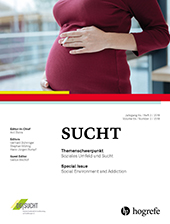Abstract
Zusammenfassung.Zielsetzung: Suchtkranke Personen und insbesondere Methamphetamin (MA) -abhängige schwangere Frauen, Mütter und Väter brauchen spezifische Hilfsangebote für sich und ihre Kinder. Am Universitätsklinikum Dresden wurde 2016 dazu das interdisziplinäre Programm „Mama denk‘ an mich“ (MAMADAM) ins Leben gerufen, dessen suchttherapeutischer Teil hier vorgestellt wird. Methode: Die Therapieaufgaben der Ärzte, Psychologen und Sozialarbeiter werden dargestellt. Spezifisch gehören dazu die MA-spezifische Gruppenpsychotherapie für schwangere Frauen und Mütter, Vorgehen beim Abstinenznachweis und bei positivem Drogentest sowie die Zusammenarbeit mit den Jugendämtern. Ergebnisse: Bislang wurden insgesamt 13 Schwangere, 49 Mütter und19 Väter vorstellig. Die Hauptsuchtmittel waren MA (65 %), Alkohol (18 %) und Cannabis (15 %). Komorbide psychiatrische Störungen lagen bei 78 % der Fälle vor, bei 56 % beinhaltete dies auch nicht suchtbezogene Störungen. 71 % waren zu Therapiebeginn überwiegend fremdmotiviert, 71 % bezogen Arbeitslosengeld II und 38 % waren vorbestraft. Die Haltequote für Patienten, die ins Therapieprogramm eingeschlossen wurden, lag bei 77 % bei einer Therapiedauer von 22 Wochen (Median). 20 Patienten wurden in stationäre Entgiftungs-/Reha-Behandlung vermittelt. Diskussion: Die behandelte Stichprobe stellt eine hoch risikobehaftete Klientel dar. Dennoch gelang es im ambulanten Setting, den überwiegenden Anteil abstinent in Therapie zu halten. Die ambulante psychiatrische Suchttherapie kann somit für Eltern eine sinnvolle Alternative zur stationären Langzeittherapie darstellen.
Abstract.Aims: Substance-dependent pregnant women, mothers and fathers require specialized care, particularly those with methamphetamine (MA) dependence. Therefore, the University Hospital Dresden launched an interdisciplinary treatment program called “Mummy, think of me” in 2016. We here describe its novel addiction-specific psychiatric outpatient treatment. Method: Task assignments of psychiatrists, social workers, and psychologists are presented in detail. Specific aspects include group psychotherapy for MA-addicted pregnant women and mothers, proof of abstinence, procedures in case of a positive drug screening, and cooperation with the youth welfare offices. Results: 68 patients (including 19 fathers) were included. The main diagnoses were MA (65 %), alcohol (18 %) and cannabis dependence (15 %). 78 % of the patients suffered from comorbid psychiatric disorders and in 56 % these were not addiction-related. 71 % were extrinsically motivated for treatment, 71 % received unemployment benefits and 38 % had a criminal record. The retention rate for patients enrolled in the therapy program was 77 %, with a median therapy duration of 22 weeks. 20 patients were referred to inpatient detoxification/rehab. Conclusions: The patient sample we enrolled was severely affected by disease and social problems. Nevertheless, our outpatient psychiatric treatment program retained most patients in stable abstinence and might therefore be a viable alternative to inpatient long-term rehabilitation programs.
Literatur
(2015). Long-term outcomes of pharmacologically treated versus non-treated adults with ADHD and substance use disorder: A naturalistic study. Journal of Substance Abuse Treatment, 51, 82–90.
(2015). Recent trends in the availability and use of amphetamine and methamphetamine in Norway. Forensic Science International, 246, 92–97.
Center for Substance Abuse Treatment . (2006). Counselor’s Treatment Manual: Matrix Intensive Outpatient Treatment for People with Stimulant Use Disorders. (DHHS Publi). Rockville, MD: U. S. Department of Health and Human ServicesSubstance Abuse and Mental Health Services Administration.Center for Substance Abuse Treatment . (2016). Das Matrix-Modell: Ambulante Intensivbehandlung bei Störungen durch Stimulanzienkonsum – Therapiemanual. Mühlhausen: SuPraT–Suchtfragen in Praxis und Theorie e. V. (Deutsche Übersetzung und Adaption).(2016). Association Between Prescription of Major Psychotropic Medications and Violent Reoffending After Prison Release. Journal of the American Medical Association, 316(17), 1798–1807.
(2015). Suchtkrankenhilfe in Deutschland 2014. Jahresbericht der Deutschen Suchthilfestatistik (DSHS).Online-Bericht. Verfügbar unter http://www.suchthilfestatistik.de.
(2016). Substanzkonsum in der Allgemeinbevölkerung in Deutschland: Ergebnisse des epidemiologischen Suchtsurveys 2015. Sucht, 62(5), 271–281.
(2017). Steigender Konsum von Crystal Meth in Sachsen und dessen Risiken für Mutter und Kind –Erfahrungen an einem Perinatalzentrum Level I aus pädiatrischer Sicht. Zeitschrift für Geburtshilfe und Neonatologie, 221(02), 73–80.
Drogenbeauftragte der Bundesregierung, Bundesministerium für Gesundheit (BMG) ,Bundesärztekammer (BÄK) ,Arbeitsgemeinschaft der deutschen Ärztekammern , &Deutsche Gesellschaft für Psychiatrie und Psychotherapie, Psychosomatik und Nervenheilkunde (DGPPN) (Hrsg.).(2016). S3-Leitlinie Methamphetamin-bezogene Störungen. Berlin Heidelberg: Springer Verlag.(2014). Effects of Educational Intervention on Health-Promoting Lifestyle and Health-Related Life quality of Methamphetamine Users and Their Families: a Randomized Clinical Trial. Iranien Red Crescent Medical Journal, 16(11), e20024.
(2011). Effects of motivational enhancement therapy on readiness to change MDMA and methamphetamine use behaviors in Taiwanese adolescents. Substance Use & Misuse, 46(4), 411–416.
(2007). Clinical Treatment Guidelines for Alcohol and Drug Clinicians. No 14: Methamphetamine dependence and treatment. Fitzroy,Victoria: Turning Point Alcohol and Drug Centre Inc.
(2015). Extended-Release Mixed Amphetamine Salts vs Placebo for Comorbid Adult Attention-Deficit/Hyperactivity Disorder and Cocaine Use Disorder – A Randomized Clinical Trial. JAMA Psychiatry, 72(6), 593–602.
(2014). Amphetamin und Methamphetamin–Personengruppen mit missbräuchlichem Konsum und Ansatzpunkte für präventive Maßnahmen. Hamburg: Zentrum für integrative Suchtforschung.
(2002). Motivational Interviewing. New York: The Guilford Press.
(2014). Randomized trial of intensive motivational interviewing for methamphetamine dependence. Journal of Addictive Diseases, 33(3), 253–265.
(2004). A multi-site comparison of psychosocial approaches for the treatment of methamphetamine dependence. Addiction, 99(6), 708–717.
(2008). Risk factors for methamphetamine use in youth: a systematic review. BMC Pediatrics, 8(48).
SLS Sächsische Landesstelle für Suchtfragen . (2017). Sucht 2016 – Bericht der Suchtkrankenhilfe in Sachsen. Dresden: SLS.(2008). Prenatal methamphetamine use and neonatal neurobehavioral outcome. Neurotoxicology and Teratology, 30(1), 20–28.
(2010). Psychosocial treatment for methamphetamine use disorders: a preliminary randomized controlled trial of cognitive behavior therapy and Acceptance and Commitment Therapy. Substance Abuse, 31(2), 98–107.
(2007). Brief intervention for students with methamphetamine use disorders: a randomized controlled trial. American Journal on Addictions, 16(2), 111–116.
Substance Abuse and Mental Health Services Administration (2016). Zur Anwendung bei Patientinnen: Eine Ergänzung zur ambulanten Intensivbehandlung bei Störungen durch Stimulanzienkonsum nach dem Matrix-Modell. Mühlhausen: SuPraT–Suchtfragen in Praxis und Theorie e. V. (deutsche Übersetzung und Adaption).(2017). Diagnosing ADHD during active substance use: Feasible or flawed? , 371–375.
(2014). Prenatal methamphetamine exposure and neurodevelopmental outcomes in children from 1 to 3 years. Neurotoxicology and Teratology, 42, 77–84.



